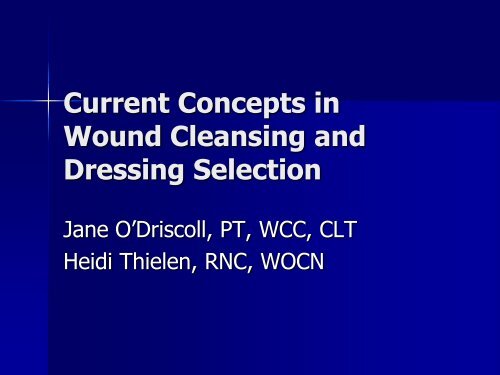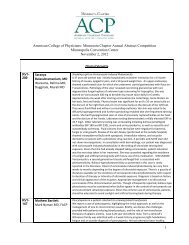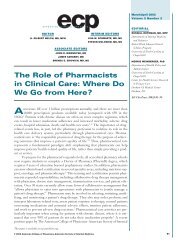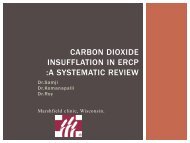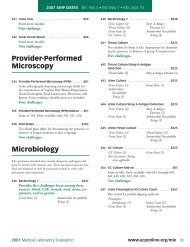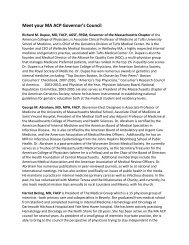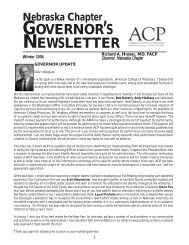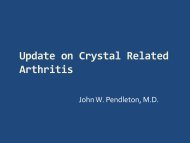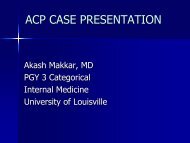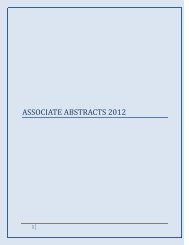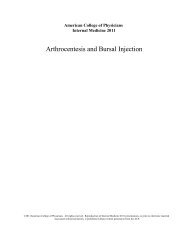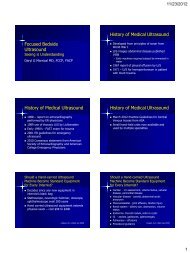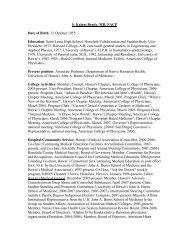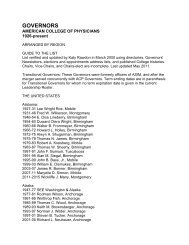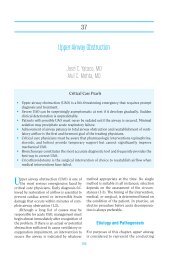Wound Cleansing and Dressing Selection
Wound Cleansing and Dressing Selection
Wound Cleansing and Dressing Selection
Create successful ePaper yourself
Turn your PDF publications into a flip-book with our unique Google optimized e-Paper software.
Current Concepts in<br />
<strong>Wound</strong> <strong>Cleansing</strong> <strong>and</strong><br />
<strong>Dressing</strong> <strong>Selection</strong><br />
Jane O’Driscoll, PT, WCC, CLT<br />
Heidi Thielen, RNC, WOCN
<strong>Wound</strong> Bed Preparation<br />
� Four Major Components<br />
1. Tissue Management<br />
2. Inflammation <strong>and</strong> Infection<br />
control<br />
3. Moisture Balance<br />
4. Epithelial Edge Advancement
Tissue Management<br />
� <strong>Cleansing</strong> with mechanical force<br />
– Normal saline<br />
– Commercial cleansers<br />
– Lactated ringers<br />
– Tap water<br />
Debridement<br />
– Mechanical<br />
– Sharp<br />
– Autolytic<br />
– Enzymatic
Infection Control<br />
� Choosing to cleanse with an antiseptic<br />
� Topical Antiseptics (<strong>Cleansing</strong>)<br />
– Betadine – gram +/-<br />
– Dakins solution – gram +/-; pseudomonas<br />
– Acetic acid – gram +/-; pseudomonas<br />
– Hydrogen peroxide
Infection Control<br />
� Topical Antibacterial<br />
<strong>Dressing</strong>s<br />
– Iodoform<br />
– Aquacel Ag;<br />
Maxsorb Ag<br />
– Silvadene<br />
– Silverlon<br />
– Acticoat<br />
– Optifoam Ag<br />
- Silver Polymem<br />
- Mepilex Ag<br />
- Xeroform
Infection Control<br />
� Topical Antibiotics – used for a limited time<br />
period when clinical infection is present<br />
– Muprirocin (Bactroban): MRSA, gram +<br />
– Polymyxin: gram -; pseudomonas<br />
– Bacitracin: wide spectrum gram + <strong>and</strong> –<br />
+ Oral <strong>and</strong> IV Antibiotics: vancomyicin;<br />
levaquin; sulfonamides (bactrim)
Epithelial Edge<br />
Advancement<br />
� Open wound edges<br />
– If epibole present, no healing will take place<br />
– Silver nitrate<br />
� Pack Dead Space<br />
– Promotes healing from the bottom up<br />
– Fill depth of wound with packing material<br />
– Do not pack tightly<br />
– Ex: wound fillers; gauze; alginates<br />
– To determine what you use: do you want to<br />
absorb exudate or hydrate the wound bed – this<br />
determines dressing choice
<strong>Dressing</strong>s<br />
� Primary<br />
– The therapeutic or protective covering<br />
applied directly to the wound base<br />
� Secondary<br />
– Materials that serve as therapeutic or<br />
protective function <strong>and</strong> are used to<br />
secure the primary dressing i.e. keeps<br />
the dressing in place
Product Categories<br />
� Alginates – primary dressing<br />
– Derived from brown seaweed<br />
– Rope or flat dressing<br />
– Sometimes impregnated with Ag<br />
– Absorbs 333% its weight in fluid<br />
– Becomes gel like when mixes with wound<br />
exudate<br />
– Ex: Kaltostat, Kalginate, Sorbsan, Curasorb,<br />
Aquacel, Maxsorb
Product Categories<br />
� Collagens – primary dressing<br />
– Freeze dried sheets of collagen, pastes,<br />
or gels usually derived from cowhide<br />
– Encourages deposition/organization of<br />
new collagen & granulation<br />
– Only use in proliferative phase<br />
– Ex: Fibercol, Won’dres, Nu gel, Medfil<br />
Pads, hyCure
Product Categories<br />
� Composites – primary or secondary dressing<br />
– Combination of 2 or more different products<br />
– Provides multiple functions – autolytic<br />
debridement <strong>and</strong> vapor exchange<br />
– Sometimes provides an absorptive function<br />
– Ex: Covaderm, Alldress, Telfa Isl<strong>and</strong>,<br />
Stratasorb; Optifoam adhesive
Product Categories<br />
� Contact Layers – primary dressing<br />
– Thin, non-adherent sheets placed in wound bed<br />
to protect against contact from other agents<br />
– Provides protection<br />
– Porous to allow fluid exchange<br />
– Often used with fillers or topical medications<br />
– Always used when bone or tendon is exposed<br />
– Can leave in wound bed up to 7 days<br />
– Ex: Tegapore, Dermanet, Mepitel, Telpha Clear,<br />
Curity Nonadherent, Vaseline Impregnated<br />
Gauze
Product Categories<br />
� Foams – primary dressing<br />
– Semi-permeable polyurethane foam, nonadherent;<br />
waterproof outer layer<br />
– Provides moist wound environment<br />
– Best for maintaining temperature of wound bed<br />
– Used on minimal to moderate drainage<br />
– Ex: Allevyn, Curafoam, Flexzan, Hudrasorb,<br />
LYOfoam, Mitraflex, Polymem, Tielle, Mepilex,<br />
Biatain, 3M Heel Foam, Comfeel Ulcer <strong>Dressing</strong>,<br />
Optifoam
Product Categories<br />
� Hydrocolloids – primary dressing<br />
– Contain hydrophilic colloidal particles in an<br />
adhesive compound laminated onto a flexible<br />
outer layer; is occlusive<br />
– Can protect intact skin or newly healed wounds<br />
– Cause autolytic debridement<br />
– Use only on non-infected wounds<br />
– Is somewhat absorptive of drainage<br />
– Ex: Exuderm, Duoderm
Product Categories<br />
� Hydrogels – primary dressing<br />
– Generally contain a 90% water gel base<br />
– Comes in gel or sheets<br />
– Donates moisture to a wound<br />
– Ex: <strong>Wound</strong> gel filler: Curasol, Curafil, Intrasite,<br />
Solosite, Carrasyn, Normigel, Amerigel, Saf-gel Gel<br />
Sheets: Dermagel, Curagel, Kendall Isl<strong>and</strong>, NDM<br />
Isl<strong>and</strong>, MPM Med Gel Pad, Elastogel, Vigilon,<br />
Tenderwet Impregnated Gauze: CarraGauze,<br />
Transigel, Curasol, Dermagran Gauze
Product Categories<br />
� Specialty Absorptives – primary or<br />
secondary dressing<br />
– Multilayered dressings consisting of highly<br />
absorptive layers<br />
– Often made of cellulose, cotton, or rayon<br />
– Use with heavy exudate<br />
– Ex: Aquacel, Combiderm, Exu-Dry,<br />
Softsorb, Tendersorb Wet-Pruf pads, ABD<br />
pads
Product Categories<br />
� Transparent Films – primary or<br />
secondary dressing<br />
– Transparent sheets with adhesive back<br />
– Occlusive<br />
– Cause autolytic debridement<br />
– Use only on non-infected wounds<br />
– Has no absorptive properties<br />
– Ex: Tegaderm, Opsite, Polyskin, Mefilm
Product Categories<br />
� <strong>Wound</strong> fillers – primary dressing<br />
– Agents that come in a variety of forms:<br />
thick paste, granules, powders, <strong>and</strong><br />
beads<br />
– Provide moist environment yet absorb<br />
some exudate<br />
– Can be used on infected wounds<br />
– Ex: Flexigel, Gold Dust <strong>Wound</strong> Filler,<br />
Iodoflex pads, Multidex
Tapes<br />
� Used to secure<br />
dressings<br />
� Types<br />
– Foam<br />
– Non woven cloth<br />
– Fabric<br />
– Paper<br />
– Plastic<br />
– Cloth<br />
– Silk
Gauze <strong>Dressing</strong>s<br />
� Commonly known as 4x4’s, 2x2’s,<br />
packing strip, kerlix, conform, kling.<br />
� Made of woven <strong>and</strong> non-woven fibers<br />
of cotton, rayon, polyester, or<br />
combination<br />
� Moderately absorptive
Gauze <strong>Dressing</strong>s<br />
� Some are impregnated<br />
– Mesalt: intended for heavily draining infected wounds<br />
– Idoform: iodine impregnated gauze packing strip<br />
– Xeroform: fine mesh gauze impregnated with<br />
petrolatum <strong>and</strong> 3% bismuth; deodorizes<br />
– Vaseline: fine mesh gauze impregnated with vaseline<br />
– Adaptic: fine mesh coated with light oil emulsion<br />
– Kerlix AMD: coated with polyhexamethylene biguanide<br />
(bacteria killing polymer); extracts bacteria from wound
Skin Sealants<br />
� Liquid skin protectors that provide a<br />
plastic type film over skin<br />
� Protects from moisture <strong>and</strong> tape<br />
damage<br />
� Ex: Skin prep, NO-STING skin prep,<br />
Cavilon Barrier Film, Hollister Skin gel,<br />
Sure prep, Benzoin spray or sticks
Prescription Products<br />
� Accuzyme Papain-Urea Ointment<br />
– Provides enzymatic debridement<br />
– Does not harm viable tissue<br />
– Digests nonviable protein necrosis<br />
– 1 st choice until necrosis is
Prescription Products<br />
� Panafil Ointment<br />
– Provides enzymatic debridement<br />
– Does not harm viable tissue<br />
– Digests nonviable protein necrosis<br />
– Use when there is
Prescription Products<br />
� Other less common<br />
– Regranex<br />
– Xenaderm<br />
– Optase Gel<br />
– Granulex Spray<br />
– Biafine
<strong>Wound</strong> Types<br />
Pressure, Venous, Arterial,<br />
Diabetic, Acute, Unusual
Pressure Ulcers<br />
� Rounded<br />
� Crater like<br />
� Regular edges<br />
� Take on shape that caused the<br />
pressure<br />
� The deeper the less likely they bleed<br />
� Often peri-wound is non-blanchable<br />
erythema
Arterial Ulcers<br />
� Location<br />
– Between toes or tips of toes<br />
– Over phalangeal heads<br />
– Around lateral malleolus<br />
– Areas subjected to trauma/rubbing footwear<br />
� Other skin characteristics<br />
– Thin, shiny, dry skin - cyanosis<br />
- Hairless - abnormal ABI<br />
– Thick toenails - poor/absent pulses<br />
– Dependent rubor - decreased skin temp<br />
– Pallor on elevation
Arterial Ulcers<br />
Continued…<br />
� Characteristics<br />
– Even wound margins<br />
– Punched out<br />
appearance<br />
– Pale, deep, wound<br />
bed<br />
– Blanched peri-wound<br />
tissue<br />
– Extreme pain<br />
– Cellulitis<br />
– Gangrene/necrosis<br />
� Dry gangrene<br />
– black non-viable<br />
tissue<br />
– Exclusive to the<br />
extremities<br />
– Tx: paint with<br />
betadine or<br />
alcohol <strong>and</strong><br />
dress with dry<br />
gauze<br />
� Unstable gangrene<br />
– Amputation<br />
required
Diabetic Ulcers<br />
� Characteristics<br />
– Painless<br />
– Even wound margins<br />
– Rounded/oblong shape over bony<br />
prominence<br />
– Deep<br />
– Surrounding callous<br />
– Cellulitis/underlying osteomyelitis
Venous Ulcers<br />
� Characteristics<br />
– Irregular wound margins<br />
– Superficial<br />
– Lumpy granulation tissue<br />
– Generally painless<br />
– Exudate is moderate to heavy initially<br />
– Surrounding skin can be weepy<br />
– Dermatitis vs. cellulitis
Venous Ulcers<br />
Continued…<br />
� Treatment:<br />
– Cleanse <strong>and</strong> choose dressings for wound<br />
– Compress<br />
– Optimize contributing factors<br />
– Elevate<br />
– Establish a maintenance plan
Venous Ulcers<br />
Continued…<br />
� Options for treatment<br />
– Unna boot<br />
– Duke boot<br />
– Circ-Aid<br />
– Multilayer compression b<strong>and</strong>age<br />
� Can get manufactured in a premade kit<br />
– <strong>Dressing</strong> <strong>and</strong> compression wraps<br />
(dependent on pt mobility/independence)
Venous Ulcers<br />
Continued…<br />
� Options for maintenance<br />
– Compression garments<br />
� Ted hose are NOT compression garments<br />
� 20-30mmHg (recommended for arms)<br />
� 30-40mmHg (recommended for legs)<br />
� 40-50mmHg (recommended for severe<br />
swelling in legs)<br />
– Compression pumps
Treatment Considerations<br />
� Other considerations…<br />
– Dry stable eschar: leave intact<br />
– Unstable necrotic tissue: aggressive debridement<br />
– Granulating wound bed: appropriate moist<br />
wound healing<br />
– Infected wound: silver products; cadexomer<br />
iodine; use precaution with occlusive dressings<br />
– Adjunctive therapies: Regranex (spendy);<br />
anodyne
� Thank you!<br />
Questions?


